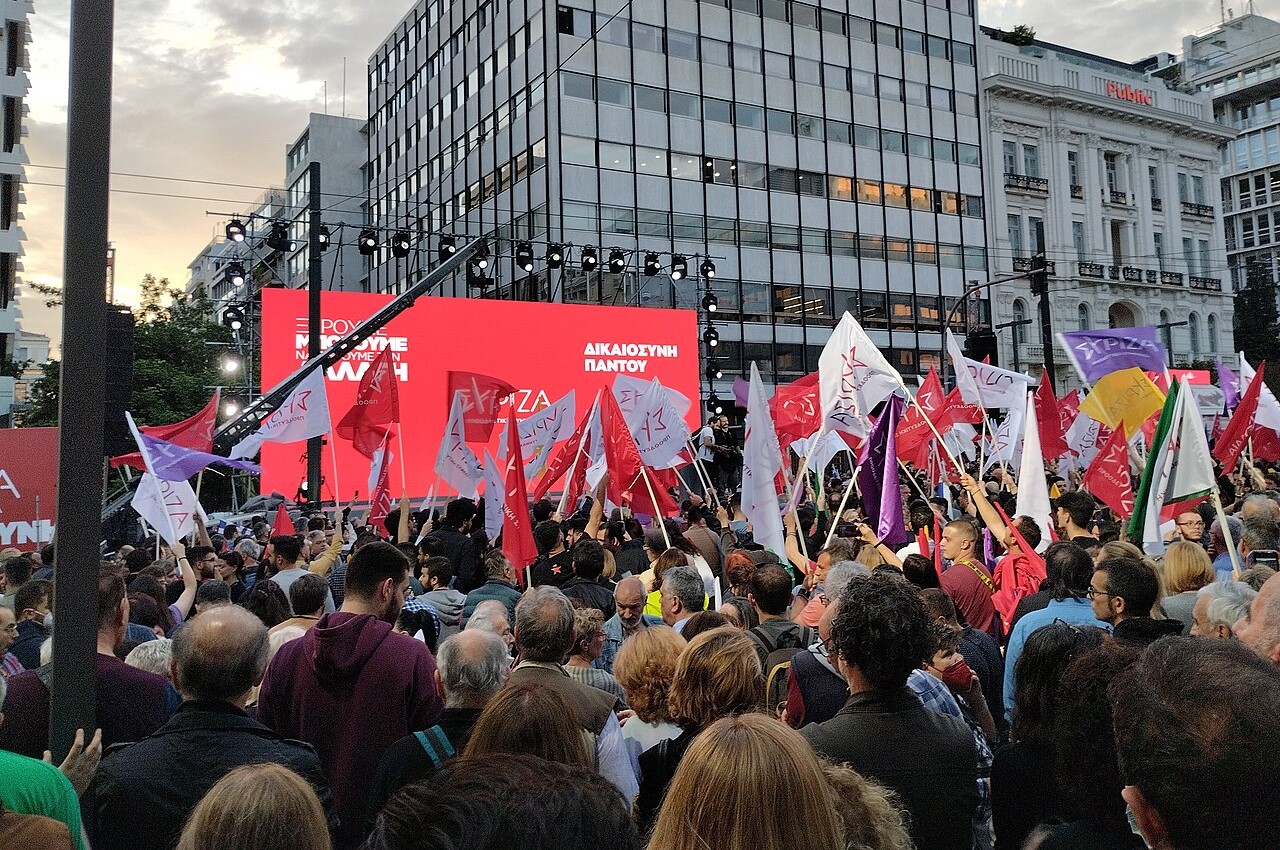Since the collapse of SYRIZA in Greece’s general election back in June, the party leadership has been captured by a populist shipping magnate. This is an ignominious but fitting ending for a party that once inspired hope among millions of workers, only to see those hopes dashed by the betrayals of the party leadership. New local elections have confirmed the party’s collapse. But while SYRIZA may be dead as a vehicle for the discontent and anger of the Greek working class, we are seeing that anger expressed in massive abstention, and to SYRIZA’s left, in the rising vote of the Communist Party (KKE).
The Greek local elections, which took place 8 and 15 October, saw a large increase in abstention, the beginning of a weakening of ruling New Democracy, a collapse of the influence of SYRIZA, and an increase in support for the KKE.
We did not see any advance for the far right, as in the June general elections, since the three far right parties were reluctant to put forward candidates of their own. In the few cases where they did, their candidates (sometimes disguised as ‘independents’) failed to achieve strong results. Although this time the hypocritical bourgeois judiciary allowed him to stand as a candidate for the municipality of Athens, the imprisoned neo-Nazi Kasidiaris saw his votes fall from 21,963 in the last local elections in 2019 to 11,643.
In general, these results clearly disprove the theories of a supposed right-wing shift or a move towards fascism, as the ‘Left’ claimed after the general elections of May and June. The leadership of SYRIZA in particular had tried to use this excuse to cover up for their own failings.
Greek society is going through a transitional phase, dominated on the one hand by political disillusionment and confusion, but also growing anger against the ruling class and its regime. The latter process, while causing some of the petty bourgeoisie to fall for far right or ‘centreground’ demagogy, in the ranks of the most politically advanced sections of the working class and the youth is fuelling a new turn to the left, with the KKE being the main beneficiary.
A slap in the face for New Democracy
These local elections saw a historic record set, with 47.47 percent abstaining in the first round, skyrocketing to 64.85 percent in the second round. In the municipality of Athens, abstention reached 67.68 percent in the first round and 73.27 percent in the second round! This reflects a mixture of frustration and anger on the part of the people, and a complete lack of faith in the bourgeois regime and existing parties.
In the days preceding the second round, prime minister Mitsotakis and the leaders of New Democracy were aiming for a victory in nine key battles: in the six contested regions and in three contested large municipalities. They won only one of those battles. In seven out of the nine (and in many other cases), their vote actually dropped in the second round, vividly showing how demoralised their electoral base is, only months after their victory in the general election.
Even in many cases where New Democracy candidates won, there was a huge reduction in their vote compared to the results of the previous local elections, or the June general election.
Whereas the ruling party previously controlled 11 out of 13 regions, it now only controls 8. It also lost control of several municipalities, including Athens and Thessaloniki. Such results are deeply worrying for the Greek ruling class, coming at a time when it needs stability in order to attack the living standards and the rights of the working class, as well as the petty bourgeoisie that forms its base, ever more vigorously.
SYRIZA collapses
 SYRIZA suffered big losses in almost all the regions and municipalities where it put forward its own candidates / Image: Pavlos1988, Wikimedia Commons
SYRIZA suffered big losses in almost all the regions and municipalities where it put forward its own candidates / Image: Pavlos1988, Wikimedia Commons
SYRIZA suffered big losses in almost all the regions and municipalities where it put forward its own candidates. For example, in the region of Attica (which includes the city of Athens) SYRIZA fell from 277,485 votes in 2019 and 295,268 votes in June, to 193,660 in the first round. In the second largest region, Central Macedonia (which includes the city of Thessaloniki), where in 2019 it had received 105,798 votes, it now fell to 58,416 votes. In the largest municipality, Athens, from 35,403 votes in 2019 it now fell to 18,668 votes. In the municipality of Piraeus, from 10,662 votes in 2019 and 12,906 in June, it fell to 6,873. The list goes on.
As for PASOK, its opportunistic choice to support joint candidacies with New Democracy and SYRIZA in several regions and municipalities afforded it some wins. But this merely masks the striking inability of PASOK to benefit substantially from the losses of New Democracy and SYRIZA. The decisive weakening of PASOK’s influence in society, which started in 2010, has only temporarily decelerated because it has been overshadowed by the crisis of SYRIZA.
The leadership of SYRIZA, pointing to some of the victories of its joint candidates with PASOK, or of PASOK candidates that SYRIZA supported in the second round, claims that its ‘progressive bloc’ is the only way to defeat New Democracy. However, the supposedly ‘progressive’ PASOK was simultaneously cooperating with New Democracy in other municipalities!
The ‘Kasselakis phenomenon’ in SYRIZA
The new leader of SYRIZA, the bourgeois demagogue Stefanos Kasselakis, is not solely responsible for this electoral disaster. However, contrary to the persistent talk of a ‘Kasselakis wave’, these results show that his leadership is not reversing SYRIZA’s poor fortunes.
After the resounding defeat of SYRIZA in the general elections, Tsipras quit like a rat fleeing a sinking ship. In the farcical leadership election (where anyone who appeared on the day of the election and paid €2 to become a party member was eligible to vote), there were initially four candidates, each less appealing to the masses than the next: Achtsioglou, Tsakalotos, Pappas and Tzoumakas.
 After the resounding defeat of SYRIZA in the general elections, Tsipras quit like a rat fleeing a sinking ship / Image: Arne Müseler, Wikimedia Commons
After the resounding defeat of SYRIZA in the general elections, Tsipras quit like a rat fleeing a sinking ship / Image: Arne Müseler, Wikimedia Commons
Tzoumakas, formally the most right-wing, is an ex-PASOK minister from the 1990s, while the other three are former SYRIZA ministers who co-signed the austerity memoranda. The most ‘left-wing’ of the four, Tsakalotos, was finance minister through SYRIZA’s stint in government, having replaced Varoufakis as more willing to enforce the reactionary policies of the troika and the Greek ruling class.
While Achtsioglou was clearly leading the polls (with Tsipras’ ‘favourite’, Pappas, not standing any chance of winning), Kasselakis, a literal outsider who was not even a member of the party, entered the race.
Kasselakis presented himself as a successful shipowner, former Goldman Sachs executive, and voluntary collaborator with Joe Biden. He stated that he wanted to “reinvent” the party, to create something like the Democratic Party of the USA, and so on. Naturally, he became the favourite candidate of the capitalist media, as well as of leading New Democracy figures. It was also an open secret that he had the support of Tsipras, but he was also publicly supported by Polakis, a well-known figure in SYRIZA who has the largest appeal amongst left-wing supporters of the party.
In the end, Kasselakis managed to win in almost all the electoral centres of the party in the first round, and again in the second round against Achtsioglou. That a populist shipping magnate could come from outside the party and, with the backing of the ruling class, win the SYRIZA leadership, and that no established party figure had the political authority to stop him, is testament to the complete political bankruptcy of SYRIZA. Kasselakis’ election is the closest thing to a death certificate for the party.
This is the logical end point of the betrayals of the Tsipras leadership since 2015. But the unexpected nature of this development led many people to speak of a ‘Kasselakis wave’. While his candidacy drew a layer of voters that otherwise would have been indifferent, this so-called ‘wave’ does not constitute any significant trend. For example, the participation both in the first and the second round (148,821 and 134,420 votes respectively) was much lower than that in the election for New Democracy’s leader in 2015 (404,078 votes), and for PASOK’s leader in 2021 (270,706 votes), and even for the merely symbolic 2022 SYRIZA leadership contest when 150,000 votes were cast with only one candidate standing, Tsipras.
Moreover, this minor ‘wave’ consists of mainly petty-bourgeois and middle-class elements who, after the collapse of SYRIZA and Tsipras’ withdrawal, are desperate to find a political ‘Messiah’. Alongside them, there are younger, educated elements, also mainly middle-class, with no previous links to the Left, who aspire to climb into state positions. And, of course, there are several existing party members connected to MPs or party bureaucrats that had the foresight to correctly discern the winner and side with him out of self-interest.
Among the mass of workers and radicalised youth there was no such ‘wave’ in favour of Kasselakis (or any other candidate). This was emphatically confirmed by the local election results. Kasselakis is being increasingly treated like a ‘single use’ leader for SYRIZA, who will do the dirty job of accelerating its bourgeois degeneration by driving out any ‘left-wing’ cadres remaining in the party, and promoting a SYRIZA-PASOK coalition as an alternative pillar of support for the regime.
KKE: electoral rise that poses historical tasks
 The results for the front of the Communist Party of Greece (KKE) showed a uniform rise relative to the 2019 elections / Image: NikosLikomitros, Wikimedia Commons
The results for the front of the Communist Party of Greece (KKE) showed a uniform rise relative to the 2019 elections / Image: NikosLikomitros, Wikimedia Commons
The results for the front of the Communist Party of Greece (KKE), Laiki Sispirosi (‘People's Rally’), showed a uniform rise relative to the 2019 elections across the country, in all regions and most municipalities. In Attica, where the majority of the working class lives and works, it also represented an increase compared to the party’s general election result in June.
In several regions, including Attica and Thessaly, and in many municipalities including most of those of the wider Athens and Piraeus area, the percentage for Laiki Sispirosi was between 12 and 16 percent. Furthermore, it won six municipalities, including Patras (the third largest in the country) for the third consecutive time, and Chaidari, Petroupoli and Kaisariani in Athens.
In the municipality of Athens, Laiki Sispirosi could have comfortably passed the second round and attempted to win. The leadership of the KKE itself bears serious responsibility for thwarting this by failing to propose electoral cooperation to the extra-parliamentary Left.
On the other side, the coalition of small, left-wing, extra-parliamentary organisations should have promptly and publicly proposed electoral cooperation with the KKE, with a joint ballot. If refused, these organisations should have taken the decision to critically support the KKE’s front, in order to increase the chances of a communist candidate passing on to the second round, as well as to prevent Kasidiaris from doing so.
After its latest electoral success, the KKE must rise to the task. Simply stating that the party is for ‘100 percent opposition’ to the governments of the ruling class is incorrect. Instead, the party should raise the need for the working class to fight for power on the basis of a communist programme.
This requires a theoretical strengthening of the KKE activists, with (for example) a genuine Marxist and Leninist assessment of the historical experience of the Stalinist regimes in the USSR, Eastern Europe, etc. The party must also advance transitional demands to raise the sights of the masses, such as nationalisations and workers’ control.
Regarding the labour movement, there should be serious preparation for lasting struggles against the government, of which all the municipalities that the party controls must decisively become a part. United front tactics are required to galvanise workers to struggle collectively for their interests. In other words, the main and imperative task now is to ‘Leninise’ the party.

